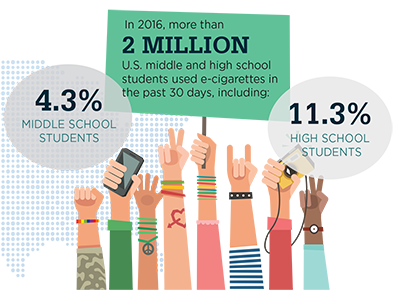Vaping becomes common for teens across the country

courtesy of the Centers for Disease Control and Prevention
Percentage of students who vape.
Streams of vapor with nicotine and cancer causing chemicals in the guise of sweet sounding flavors can be seen puffed into the air by teens in schools across the country. It seems students are taking puffs as frequently as reaching for a piece of gum, yet the risks have yet to be exposed and openly discussed. The consequences of vaping could be tragic for teens who deserve to know.
The Greater Latrobe School District has acknowledged the serious addiction problem that is inflicting harm on teens across the country and admit that it is taking place in our community.
“We have had a number of kids this year that we have caught,” GLHS principal Jeff Ingel said. “I won’t give you the number but there are quite a few that we have caught.”
A 2016 report by the U.S. Surgeon General shows a 900% increase in vaping by high school students since 2011. While many in the community would like to believe that vaping does not affect GLSD, the reality is unfortunate. Students at Greater Latrobe and all across the country are dealing with the presence of e-cigarettes in their schools.
The most common form of e-cigarette present on campus and popular to teens is the Juul. This vape device resembles a flash drive and has the capability to be charged into the USB port of a computer. Due to its disguised design and small size, students across the country are sneaking these seemingly innocent devices on campus.
While the Juul was created to help adult smokers fight their addiction, the product has landed into the hands of young adolescents seeking popularity with this new “recreation.”
The Juul comes in many flavors such as mango, mint, cucumber, and creme brulee that entice teens and creates a false appearance of “confectionery comfort.”
“Yeah they make it fruity so that way We, the younger generation, are drawn to it,” said a junior at GLHS who admits to juuling on a regular basis.
Ingel added, “The Juul company is now trying to backtrack and make some changes to what they did, because they realize the effects that it’s having. This is an epidemic with teenagers. It really is.”
While the media and government worked hard to inform citizens and especially youth of the effects of smoking– with graphic commercials that depict the changes over time to the lungs–some believe vaping has yet to be publicly examined.
A Greater Latrobe senior who admits to juuling during school said, “ I don’t think the media has done any ad campaigns or alerted the public like they have for smoking side effects.”
Juuling has side effects, GLHS senior added, “Juuling will have side effects later but not now….Late 30’s is when the side effects will start showing up, like maybe cancer but only for people who do it heavily.”
The Center for Disease Control and Prevention recently announced results of their newest report which found 1 in 11 students have used e- cigarettes to vape marijuana.
GLHS is in the process of scheduling special guest speakers to come and speak to the student body about possible risks that have yet to be fully discussed. The administration is working hard to get in front of this epidemic by alerting the students and being clear about the consequence of possession.
“If we find a student with the Juul cigarette in possession or actually in the process of juuling obviously they’re brought to the office. The cigarette itself is confiscated. Parents are called. There could be a three day suspension, and they could have up to five hours of community service,” Ingel explains. “They will also receive what is called a Smokeless Saturday which is a three hour class that costs $50 dollars that obviously has to be paid by the guilty student. If they don’t take the class then charges are filed with the magistrate for possession of tobacco in school, and that could be up to a $300 dollar fine.”
While the consequences are severe if caught in possession, the health and substance information have yet to be shared.
In reality a single Juul “Pod”– that holds roughly 200 puffs– contains not only the equivalent amount of nicotine as a pack of cigarettes, but also numerous chemicals that have been reported to cause deleterious side effects.
The Center for Disease Control and Prevention found, “The e-cigarette aerosol that users breathe from the device and exhale can contain harmful substances, including nicotine, ultrafine particles that can be inhaled deep into the lungs, flavoring such as diacetyl– a chemical linked to a serious lung disease, volatile organic compounds, cancer-causing chemicals, and heavy metals such as nickel, tin, and lead.”
With students uninformed of these serious health risks, this trending addiction is rapidly spreading across the country.
According to the Center for Disease Control and Prevention, In 2016 alone, 2.6 million students had admitted to using e-cigarettes in a 30 day span.
Many might wonder how students have been able to obtain these nicotine devices so easily.
The FDA on September 12, 2018 released its findings from the largest coordinated enforcement effort in its history. The agency sent over 1,300 letters that warned shops across the country of their illegal sale of Juul’s and other e-cigarettes. Through an undercover operation, the FDA was able to potentially stop the sale of illegal substances to minors by threatening possible fines.
While many would like to believe that this new form of addiction is not taking place in their community, a deeper evaluation will reveal that it is a serious issue young teens are dealing with throughout America.
Local communities, school districts, and government agencies at both the state and federal level need to alert students of these major risks. With the nation’s focus on ending the opioid epidemic, there should be a deeper focus on educating and informing the next generation of adults. Teens need to be informed of these serious risks. We should not sit idly by while the next generation of adults become addicts. Greater Latrobe is taking the necessary and proper steps to be at the forefront of education about vaping and prevention of addiction.

I grew up here in PA, but spent the last 8 years in CA and just returned to finish out my Senior year at Greater Latrobe. It’s great to be back here--...












